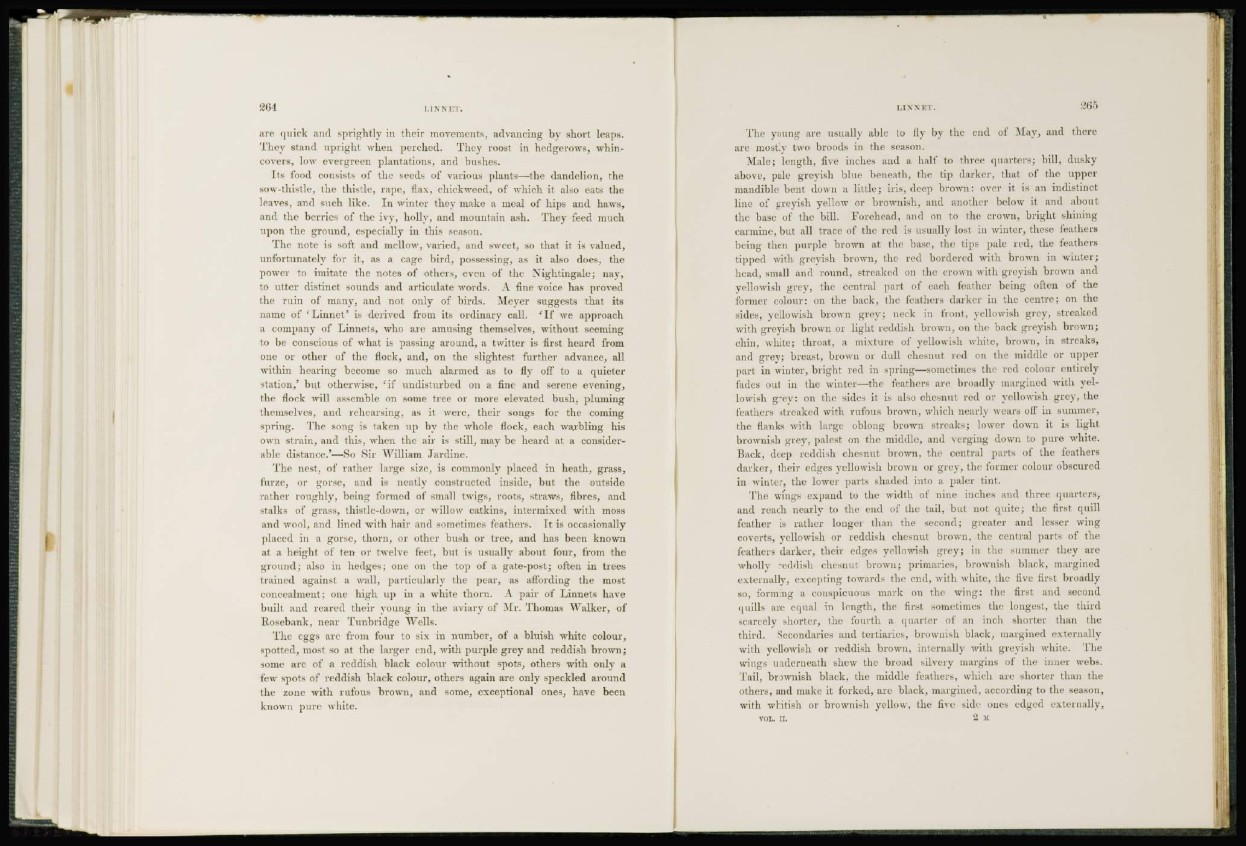
are quick and sprightly in their movements, advancing by short leaps.
They stand upright when perched. They roost in hedgerows, whincovers,
low evergreen plantations, and bushes.
Its food consists of the seeds of various plants—the dandelion, the
sow-thistle, the thistle, rape, flax, chickweed, of which it also eats the
leaves, and such like. In winter they make a meal of hips and haws,
and the berries of the ivy, holly, and mountain ash. They feed much
upon the ground, especially in this season.
The note is soft and mellow, varied, and sweet, so that it is valued,
unfortunately for it, as a cage bird, possessing, as it also does, the
power to imitate the notes of others, even of the Nightingale; nay,
to utter distinct sounds and articulate words. A fine voice has proved
the ruin of many, and not only of birds. Meyer suggests that its
name of 'Linnet' is derived from its ordinary call. *If we approach
a company of Linnets, who are amusing themselves, without seeming
to be conscious of what is passing around, a twitter is first heard from
one or other of the flock, and, on the slightest further advance, all
within hearing become so much alarmed as to fly off to a quieter
station,' but otherwise, 'if undisturbed on a fine and serene evening,
the flock will assemble on some tree or more elevated bush, pluming
themselves, and rehearsing, as it were, their songs for the coming
spring. The song is taken up bv the whole flock, each warbling his
own strain, and this, when the air is still, may be heard at a considerable
distance.'—So Sir William Jardine.
The nest, of rather large size, is commonly placed in heath, grass,
furze, or gorse, and is neatly constructed inside, but the outside
rather roughly, being formed of small twigs, roots, straws, fibres, and
stalks of grass, thistle-down, or willow catkins, intermixed with moss
and wool, and lined with hair and sometimes feathers. It is occasionally
placed in a gorse, thorn, or other bush or tree, and has been known
at a height of ten or twelve feet, but is usually about four, from the
ground; also in hedges; one on the top of a gate-post; often in trees
trained against a wall, particularly the pear, as affording the most
concealment; one high up in a white thorn. A pair of Linnets have
built and reared their young in the aviary of Mr. Thomas Walker, of
Rosebank, near Tunbridge Wells.
The eggs are from four to six in number, of a bluish white colour,
spotted, most so at the larger end, with purple grey and reddish brown;
some are of a reddish black colour without spots, others with only a
few spots of reddish black colour, others again are only speckled around
the zone with rufous brown, and some, exceptional ones, have been
known pure white.
The young are usually able to fly by the end of May, and there
are mostly two broods in the season.
Male; length, five inches and a half to three quarters; bill, dusky
abovc, pale greyish blue beneath, the tip darker, that of the upper
mandible bent down a little; iris, deep brown: over it is an indistinct
line of greyish yellow or brownish, and another below it and about
the base of the bill. Forehead, and on to the crown, bright shining
carmine, but all trace of the red is usually lost in winter, these feathers
being then purple brown at the base, the tips pale red, the feathers
tipped with greyish brown, the red bordered with brown in winter;
head, small and round, streaked on the crown with greyish brown and
yellowish grey, the central part of each feather being often of the
former colour: on the back, the feathers darker in the centre; on the
sides, yellowish brown grey; neck in trout, yellowish grey, streaked
with greyish brown or light reddish brown, on the back greyish brown;
chin, white; throat, a mixture of yellowish white, brown, in streaks,
and grey; breast, brown or dull chesnut red on the middle or upper
part in winter, bright red in spring—sometimes the red colour entirely
fades out in the winter—the feathers are broadly margined with yellowish
grey: on the sides it is also chesnut red or yellowish grey, the
feathers streaked with rufous brown, which nearly wears off hi summer,
the flanks with large oblong brown streaks; lower down it is light
brownish grey, palest on the middle, and verging down to pure white.
Hack, deep reddish chesnut brown, the central parts of the feathers
darker, their edges yellowish brown or grey, the former colour obscured
in winter, the lower parts shaded into a paler tint.
The wings expand to the width of nine inches and three quarters,
and reach nearly to the end of the tail, but not quite; the first quill
feather is rather longer than the second; greater and lesser wing
coverts, yellowish or reddish chesnut brown, the central parts of the
feathers darker, their edges yellowish grey; in the summer they are
wholly reddish chesnut brown; primaries, brownish black, margined
externally, excepting towards the cud, with white, the five first broadly
so, forming a conspicuous mark on the wing: the first and second
quills are equal in length, the first sometimes the longest, the third
scarcely shorter, the fourth a quarter of an inch shorter than the
third. Secondaries and tcrtiaries, brownish black, margined externally
with yellowish or reddish brown, internally with greyish white. The
wings underneath shew the broad silvery margins of the inner webs.
Tail, brownish black, the middle feathers, which are shorter than the
others, and make it forked, are black, margined, according to the season,
with whitish or brownish yellow, the five side one.-, edged externally,
VOL. II. 2 M: